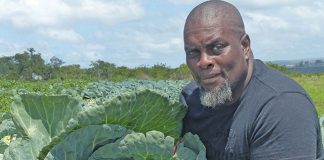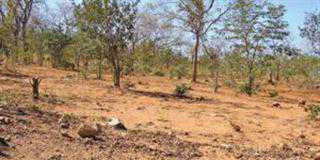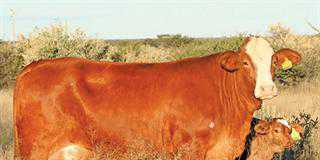“We’re experiencing the worst drought in 100 years. The last time we had decent rain, anything over 30mm at a time, was in 2006,” says Nguni stud breeder Trenly Spence whose farm, Krigerskraal, is south of Graaff-Reinet in the Camdeboo Conservancy. It encompasses 3 300ha and he rents the neighbouring farm of 3 800ha. His family has been farming in the Camdeboo for 120 years.
“Other Karoo farmers have had their best season ever, but our area is now so dry that the few millimetres we’ve been getting isn’t enough to get the veld going.”
The drought-stricken area extends from the conservancy towards the Aberdeen siding and Pearston. Rainfall in the area has been highly erratic, with the result that two farms recently had 100mm, while neighbours, including Trenly got only 1,5mm.
“As a holistic farmer, I plan for drought because dry spells of six months are nothing unusual here,” he explains. “Our rainfall records show that we can expect a one-year drought every 15 years or so, but this is something else. With holistic farming you have to reduce stock numbers during drought, but this time I’ve had to drastically reduce my commercial stock and even rethink my stud.”
Trenly explains that the first to go were the Angora kapaters. “Over the past two years I’ve sold 500 at a time, and am now down to my last 600. There is no sentiment involved because I buy them in as year-olds for about R280 and sell them at four years for about R350 each. Over the same period I more reluctantly reduced my Dorper ewe flock from 1 800 to 900.
Breeding stock is much more difficult to sell because sentiment comes into it. I am most sentimental about my Nguni stud herd. I have 100 productive cows, and know each of them well. They are distinctive, they live long – my oldest breeding cow is 15 – and I’ve recorded all the animals and their calves over 15 years.
“As soon as sentiment is involved, it takes too long to decide about selling stock. So I’ve decided to reduce my cow herd and introduce an ox component that can be sold off without sentiment in times of drought.”
Trenly and three other Nguni stud breeders Kevin Watermeyer, Stephan Kirsten and Niel Hugo hold an annual heritage auction in September.
“This year is our fourth auction and instead of selling my usual 30 cows, I’m going to sell up to 50. I’m also going to castrate and keep all the weaner bulls that are not selected for stud, and grow them out as oxen.”
At the auctions over the past couple of years, Trenly has received an average of R10 000 to R11 000 per cow with calf and an average of R5 000 to R8 000 per open heifer. The bulls averaged R16 000, after being veld-tested in the mountains for two to three years.
Bringing back veld grasses
Trenly has spent the last 18 years working with nature to bring back the grasses that were once on his farm. “I try to be led by the veld so that nature shows me the way,” he says. “When we have rain, there are places on the farm that are spectacular and grasses return like white buffalo grass (Panicum maximum) and blue buffalo grass (Cenchrus ciliaris) on the flats and vlei areas. Then there’s red grass (Themeda triandra) in the mountains.
“Most of the perennial grasses don’t die during drought. They just lie dormant, and holistic farming has shown me what the veld can achieve with care.
“When I first read Allan Savory’s book Holistic Management in 1992, followed by a course presented by Dick Richardson, it was a turning point in my farming. The lights went on for me. Holistic farming has certainly helped us to survive longer through droughts due to sustainable veld management.
“I’m confident that when it rains, the veld will recover sooner than on farms practising conventional methods. I’ve seen this happening after previous droughts.”
He explains that holistic management uses smaller camps and more of them. This allows for shorter grazing periods and a minimum of six-month resting periods per camp, and even longer in the mountains.
Because of this, grass root stocks are stronger than in continuous grazing or conventional farming systems with large camps and longer grazing periods, where the more palatable species start drawing on their rootstocks to survive.”
Trenly has subdivided his farm into 90 camps and the rented farm into 40 camps, using a combination of conventional and electric fencing.
Global warming to blame?
Does Trenly think global warming is causing the drought? “I hope not. I don’t want to see another drought like this in my lifetime. You read so much about global warming that you start fearing that this is what’s lying ahead for us.
“But the records show that there have been severe droughts in this area four times in the past 100 years,” he points out. “The last one lasted 19 months, which was less severe than the current 25 months. Perhaps global warming is part of it, but I think drought also goes with the territory. We just hope it breaks soon.
“And when it does, I look forward to sending in photos of how well our veld has recovered, in contrast to the photos you see now.”
Contact Trenly Spence on 082 898 4960 or e-mail [email protected].













